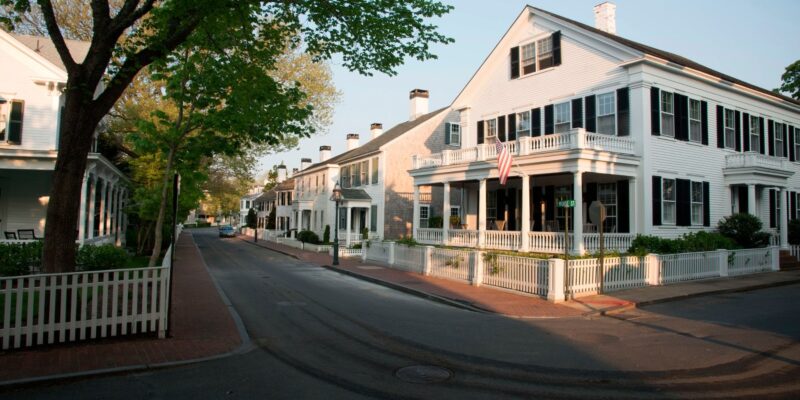
The afternoon of July 4, 2023, in Edgartown, Massachusetts—one of the six towns that make up the island of Martha’s Vineyard—was muggy and threatening rain. Near the top of Main Street, the participants of the local parade mustered, eying the sky. There was a tractor from Morning Glory, the popular farm stand on the edge of town. The fire department had rolled out its restored 1855 hand-pumped Button Tub. The staff and campers of Camp Jabberwocky, the nation’s oldest sleepaway camp for people with disabilities, had donned costumes, and the local football team, the Vineyarders, dressed in their vibrant purple home jerseys, prepared to ride an astroturfed float.
Amid the Americana of it all, some 20 members of the Coalition to Create the MV Housing Bank rallied for the island’s uneasy present: a housing crisis is threatening to gut the local community. “Please Gimme Shelter”—their plaintive slogan—was printed on placards and gray T-shirts. As the parade rolled to a start, it began to drizzle. Noah Lipnick, the dark-haired, 6-foot-5 oyster farmer who doubles as the group’s spokesman, hoisted his half of a “Housing Is a Human Right” banner.
The Vineyard, where Florida Gov. Ron DeSantis famously stranded a planeload of migrants in a grandstanding effort to highlight the hypocrisy of the liberal elite, occupies an outsize place in the national imagination. It’s where Ted Kennedy drove off of Dike Bridge, where the Clintons have vacationed and the Obamas own a $12 million home. It’s where Larry David called Alan Dershowitz “disgusting” to his face for supporting Donald Trump, and where Spike Lee summers. About 200,000 tourists come here each year to bask in that reflected glow, hit the beach, eat some ice cream, and jump off the bridge from Jaws.
But come Labor Day, when the wealthy tourists return to New York, Boston, or LA, the island is home to a decidedly more working-class populace: the 17,000 year-round residents—teachers and doctors, carpenters and fishermen, old island families and immigrants (almost a third of island high schoolers speak Portuguese at home)—who are increasingly being squeezed out. I grew up on the island, and I’ve watched the pressure build for decades.
The parade route through Edgartown’s postcard-perfect downtown of white colonial-era homes and boutique shops serves as a tour of the coalition’s complaint. A block up from the start of the route, a 1,604-square-foot five-bedroom house had sold a year earlier for $1.6 million, despite scuffed floors, basic appliances, and a few dangling shingles. As the parade headed down Edgartown’s main drag, it passed a similarly neglected 1,222 square-foot two-bedroom that had sold for $1.7 million in the fall, and what was advertised as an “elegant and well-appointed” 481-square-foot one-bedroom recently purchased for $805,000. As the route hit the harbor and wound back inland, it passed a “classically styled” 2,079-square-foot three-bedroom that sold in April for $12.6 million—a 338 percent markup over its August 2020 sale price—and the 4,388-square-foot six-bedroom harbor-front home that changed hands for an even $15 million in January 2023. If you have a large trust fund or work in finance, the Vineyard is a summer playground. If not, well, the pickings have grown slim.
The housing bank is part of the community’s big plan to change things. Alongside a dozen other cities and towns across the state, the island is fighting for the ability to levy a transfer fee on high-end real estate sales—a mansion tax—to fund year-round housing. The idea has overcome local skepticism and also won the backing of the Mass General Brigham hospital system, the state’s largest private employer and the parent company of the island hospital, which faces staffing shortages both on the Vineyard and elsewhere because of high housing costs. Using money raised by the transfer fee, which requires state legislative approval to impose, the housing bank would be free to buy and build housing that serves a wider population than traditional affordable housing.
There’s still opposition, though: The Massachusetts Association of Realtors, for one, claims the fee will only push homeownership further out of reach and burden many middle-class homeowners. “For every $1,000 increase in the price of a home, 1,727 Massachusetts residents are priced out,” Mark Kavanagh, the association’s government affairs committee chair, said at a hearing in October.
What’s pushing prices up, though, isn’t fees so much as competition for short-term rental properties and second (or third or fourth) homes, and it shows no sign of stopping. “The Vineyard has a crystal ball: It’s called Nantucket,” where the median home price is now $3 million, says Tucker Holland, Nantucket’s municipal housing director, who has led that island’s push for a transfer fee.
As they marched in the parade, the housing bank organizers waved cutouts of houses attached to the end of sticks. One member’s grandkids threw T-shirts into the crowd. “Whenever we turned a corner, there was a crescendo,” says Lipnick. “Maybe I’m biased, but I think people cheered a little bit louder as we passed by.” By the parade’s end, the sky had opened to a downpour. Shivering, their message sent, the housers all ran for cover.

Edgartown harbor and homes.
John Greim/LightRocket/Getty
The housing crisis and inequality are intertwined. Homeownership is the primary way Americans build wealth, which can be leveraged to pay for education or cover medical bills. But real estate is also a popular investment: Wall Street investors have gone on buying sprees in unflashy subdivisions across the country and private equity firms have become landlords, though even they are having trouble finding houses these days. During the pandemic, the richest 5 percent of Americans—6 million households—saw their wealth increase by an average of $140,000, according to the Brookings Institution, and that cash poured fuel onto an already hot housing market. Low interest rates benefited people who had money for a down payment.
Resort towns face an exaggerated version of this crisis. Havens beset by the 1 percent—like Jackson Hole, Wyoming; Vail and Aspen, Colorado; and Nantucket, Provincetown, and the Vineyard in Massachusetts—have seen working- and middle-class housing disappear. Seasonal rental properties, including Airbnbs, often cannibalize the market. In one extreme case, Boston-area investor David Malm has spent nearly $100 million since 2021 buying up properties on the Vineyard and Nantucket, including a house in Edgartown that he rents for $45,000 per week.
It didn’t used to be this way. “I think the money followed the political celebrity,” says John Abrams, a member of the coalition and longtime housing advocate on the island. Bill Clinton picking the Vineyard for his presidential vacations in the ’90s changed the nature of the place. “When I came here [in the 1970s], there were campgrounds. Parents had a little piece of land at the back of a piece of land. There were shacks in the woods. I mean, housing was easy.”
Valerie Reese moved to the Vineyard in 1975, when she was 23, after visiting with her parents in the summer. She rented a 625-square-foot apartment overlooking Lagoon Pond with a steep staircase up to a loft, the whole place flooded with light from 31 windows, for $115 a month—equivalent to about $650 today. (A comparable Airbnb now rents for $3,640 per week, before taxes.) She made art and worked at a Greek restaurant called Helios in Vineyard Haven, next to the Nobnocket car repair shop co-owned by James Taylor, which also birthed an artists’ guild. “To me, living on an island in New England was the most romantic thing I could think of…And so I did, and I don’t regret it,” she says.

An estate in Chilmark, one of the six towns that compose Martha’s Vineyard.
Keith Bedford/The Boston Globe/Getty
When the property was sold in 2014, Valerie discovered how much had changed. Over the next five years, she moved 21 times. A client-turned-friend built a little in-law apartment and offered it to Valerie, but later sold the house as property values soared. After that, Valerie started spending winters in a relative’s house and vacating come summer, a seasonal migration known as “the island shuffle.”
“Right now, I’m living in a shack—cold water, composting toilet, outdoor shower—that belongs to a friend of mine. And it’s fine, but I’m 70 years old,” she said last summer. “This is no way to live.” If she can’t find a permanent place by this summer, she’ll have to move off island, she says.
Although the exodus of long-time islanders is hard to quantify, Valerie clearly isn’t alone in her struggles. “Thirteen-ish years ago when I moved here year-round, there were still listings [for long-term rentals] in the newspaper,” says Arielle Faria, co-chair of the Coalition to Create the MV Housing Bank, who lives in a sought-after affordable rental built by the Island Housing Trust. “But in the past few years, the winter rentals have either gone up to crazy prices, or they completely disappeared.” Hundreds apply for the rentals that do pop up. Between 2012 and 2022, the island suffered a net loss of 850 year-round units. Now, just 39.2 percent of the housing stock is available for year-round habitation. Local businesses have started building their own housing simply to ensure their workers have places to live.
“Martha’s Vineyard is profoundly unaffordable to the point where no normal person could conceivably be able to live there and own a home there,” Dylan Fernandes, the state representative for Falmouth, Martha’s Vineyard, and Nantucket, tells me. Between 2012 and 2022, the median price of a home on the island more than doubled, far outpacing wage growth.
The compounding effects of the housing crisis can destroy communities, says Laura Silber, the island housing planner for the MV Commission, which coordinates policies across the six towns. “I don’t think anyone really realizes how much these rural communities run on volunteers,” Silber says. “When you lose year-round residents, you lose those volunteers—at the fire department, at the food pantry, at the library, in the school district, the Little League coaches—everything falls apart.” The informal social fabric starts to shred, which starts a cycle of having to fund new town services that had been performed by those volunteers and neighbors. “That pushes taxes up—a lot—and that pushes more people out.” On Nantucket, some firefighters have to commute to the island. In Sun Valley, Idaho, workers live out of their trucks and in garages, and teachers, police, and firefighters rely on local food banks. The Martha’s Vineyard Hospital, which hires 160 seasonal medical staff, has struggled to find them places to live; the school system has reported losing 7 to 10 teachers per year because of housing.
Right now, the Vineyard needs to do something big, says Silber. “If you want to disrupt a trajectory, you have to change the rules of the game.”
The housing bank takes a swing at doing just that, at least on a local scale, by using the momentum of the housing market. It would use funds raised by a proposed 2 percent transfer fee that kicks in after the first $1 million to provide loans and grants to projects that create and protect year-round housing. For instance, converting an existing house into income-restricted apartments or paying the owner of a seasonal rental a lump sum for a deed restriction that mandates the home would only be rented year-round going forward. Significantly, the proposed plan would be more expansive than the island’s current affordable housing options—year-round residents who earn up to 240 percent of the area’s median income would be eligible for assistance (the cutoff is now 80 percent), helping people like teachers and medical staff who fall somewhere in between. (The area median income for a family of three is about $112,450.)
The proposed fee, projected to bring in $12 million a year, is expected to add 38 units per year with minimal new development. It’s a modest victory—preliminary projections from the MV Commission show the island needs to secure 2,500 deed restricted units for year-round housing over the next decade—but it’s an important part of a larger push that gives the community a chance to dig in.
This is the Vineyard’s third push for a housing bank, and public support for the effort is testament to how much has changed since the idea was first introduced. The first attempt, in 2005, fell to a lobbying blitz at the statehouse by realtors, even as real estate agents on the island supported it. A second one, in 2019, would have raised funds by taxing short-term rentals, but it failed to pass critical votes at town meetings, where the latest effort has won overwhelming majorities. “We cast the net wide and focused on inclusion and understanding” in conversations with the community, says Julie Fay, the other co-chair of the Coalition to Create the MV Housing Bank. “No one felt that we snuck up and jumped in.”
This fall, Massachusetts’ Democrat Gov. Maura Healey included a transfer fee provision in a $4 billion affordable housing bill, which is itself a huge victory. (Charlie Baker, the state’s former Republican governor, opposed the idea.) There are important discrepancies between what’s in the bill and what islanders and transfer fee advocates from other communities have advocated for, including the sale price at which the fee kicks in. In January, islanders traveled to the statehouse in Boston in January to testify and press their case. In the months ahead the coalition of communities across the state must continue to use their political muscle to shape the bill’s language and push it to passage. If the bill passes, which seems like a real possibility, every town in the state will have a new tool to fight the housing crisis, if they choose to use it.

Victorian houses in Oak Bluffs on Martha’s Vineyard.
John Greim/LightRocket/Getty
For islanders, Healey’s bill would bring them one step closer to building their bank—it would enshrine the transfer fee, as well as a “seasonal communities” designation that would put other housing tools on the table. But the transfer fee is just the foundation. Next comes sorting out the nitty gritty of how the bank will operate, and this will require the familiar challenge of trying to organize the six towns of Martha’s Vineyard to work together in their collective self-interest. As the past has shown, that may not be easy.
Will the bank be enough, in any case? I was thinking about this late last summer as I took the ferry to Nantucket, where my dad is from, for a family funeral. Passing Old North Wharf on the way to the church, Dad told me his grandfather used to live in one of the fishing shanties—now multi-million dollar cottages—perched over the water. Malm, the developer, bought one in 2021 for $6.5 million. Its façade bears a wooden plaque that reads “Essex,” for the doomed Nantucket whaleship that inspired Herman Melville’s Moby Dick. Like so much else about the place, this historic detail had been refashioned as tourist kitsch—just a dash of local flavor.
If Nantucket’s situation is a warning, the message is both to not wait and that it’s never too late to try. Holland, for one, hasn’t given up hope. After all, he says, the housing bank battle isn’t just about saving communities teetering on the brink. It’s about giving every town the tools to avoid such “dire circumstances” and ensure “they don’t ever have to get even close to that.”















